Paper Machines: An Interview with Markus Krajewski
The index card and the card index
Brian Dillon and Markus Krajewski
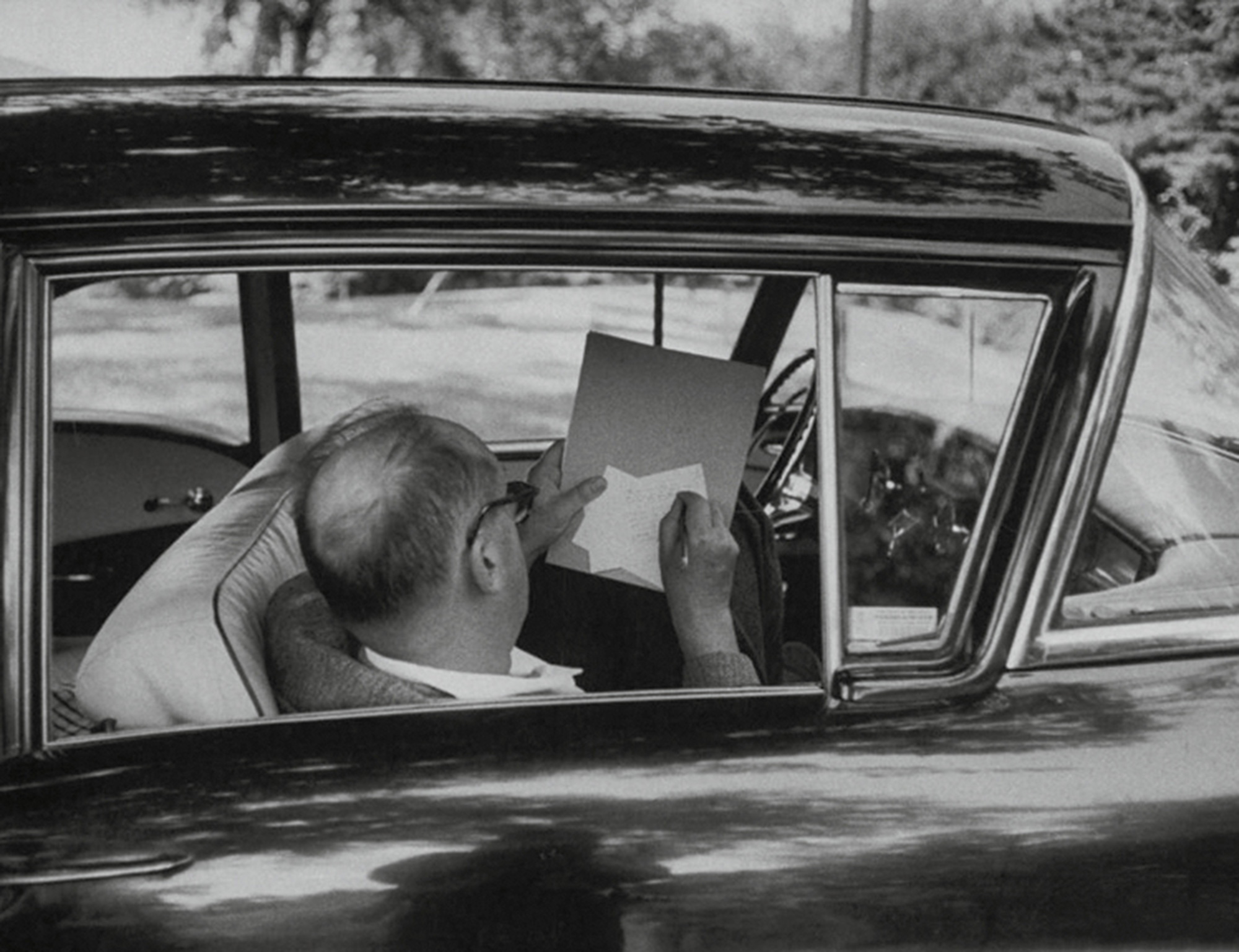
“The pattern of the thing precedes the thing. I fill in the gaps of the crossword at any spot I happen to choose. These bits I write on index cards until the novel is done. My schedule is flexible, but I am rather particular about my instruments: lined Bristol cards and well-sharpened, not too hard, pencils capped with erasers.” Thus Vladimir Nabokov, interviewed by the Paris Review in 1967, on the subject of his famously dispersed and piecemeal writing habits. The index card is an especially reified item of stationery in literary-historical terms: one thinks of Gisèle Freund’s photographs of Walter Benjamin at work with his cards at the Bibliothèque Nationale in Paris, or novelist Nicholson Baker’s 1994 essay-elegy “Discards” on the disappearing library card index. Nabokov’s distinction between “pattern” and “thing” suggests how these two aspects of the index card—tool of writing practice and element of information systems—may be related. The card’s hardware is nothing without the software of an overarching system, whether the user is a solitary writer or a scholar faced (a rare occurrence now) with the massed drawers of a major research library’s card index.
The card index, in its enclosing cabinet, is a model for the information systems that supplanted it in the twentieth century. In his new book Paper Machines (MIT Press), Markus Krajewski, associate professor of media history at the Bauhaus University, traces the history of index cards and card indexes: from Konrad Gessner’s paper-slip prototype in the sixteenth century through the wayward cataloger William Croswell’s accidental rediscovery of the method at Harvard in the early nineteenth century to Melvil Dewey’s popularization of card catalogues in business and bureaucracy as well as libraries. Brian Dillon interviewed Krajewski in September 2012.
Cabinet: The development of the card index among scholars, librarians, and bureaucrats seems to be linked throughout its history with a perceived glut of information or material: a “book flood.” What are the specific advantages of the card catalogue, which Konrad Gessner originates in the sixteenth century, when it comes to dealing with that profusion?
Markus Krajewski: One strategy to tackle the glut of books and information is to provide synopses and lists. This is what Gessner develops with his Bibliotheca Universalis of 1548: an alphabetically and systematically ordered register of all the books of his time—at least those he knew of, and he was a meticulous collector of book-trade catalogues and publishers’ announcements. In order to compile this bibliography, Gessner had to develop new methods and techniques. He not only had to rearrange and sort individual items; he had to standardize the information he found in booksellers’ catalogues and the references in the books he read. Every reference to a book had to contain author, title, printer, place, and year of publication: in fact, all the core information that still makes up a bibliographic record today. So Gessner not only paved the long way to modern bibliography, but his project also set the first standards of orientation and navigation in the ocean of knowledge that early modern scholars were exploring gradually, publication by publication.
But the greatest advantage of Gessner’s work is that he was explicit in describing how to prepare huge bibliographies. He recommends, for example, singling out each piece of information—be it a bibliographic set of data, a swift thought, or an elaborate idea—on slips of paper in order to shuffle through them more easily. He delivers nothing less than a five-step algorithm for how to proceed with huge data processing. First, when reading, everything of importance and whatever appears useful should be copied onto a good sheet of paper. Second, a new line should be used for every idea. Third, cut out those core elements with a pair of scissors. Fourth, arrange the slips as you desire, e.g., into larger clusters that can then be subdivided again as often as necessary. Fifth, as soon as the desired order is produced, arranged, and sorted on tables or in small boxes, it should be fixed or copied directly. So the Bibliotheca Universalis not only sets a new standard in terms of content, but also in the format of the records.
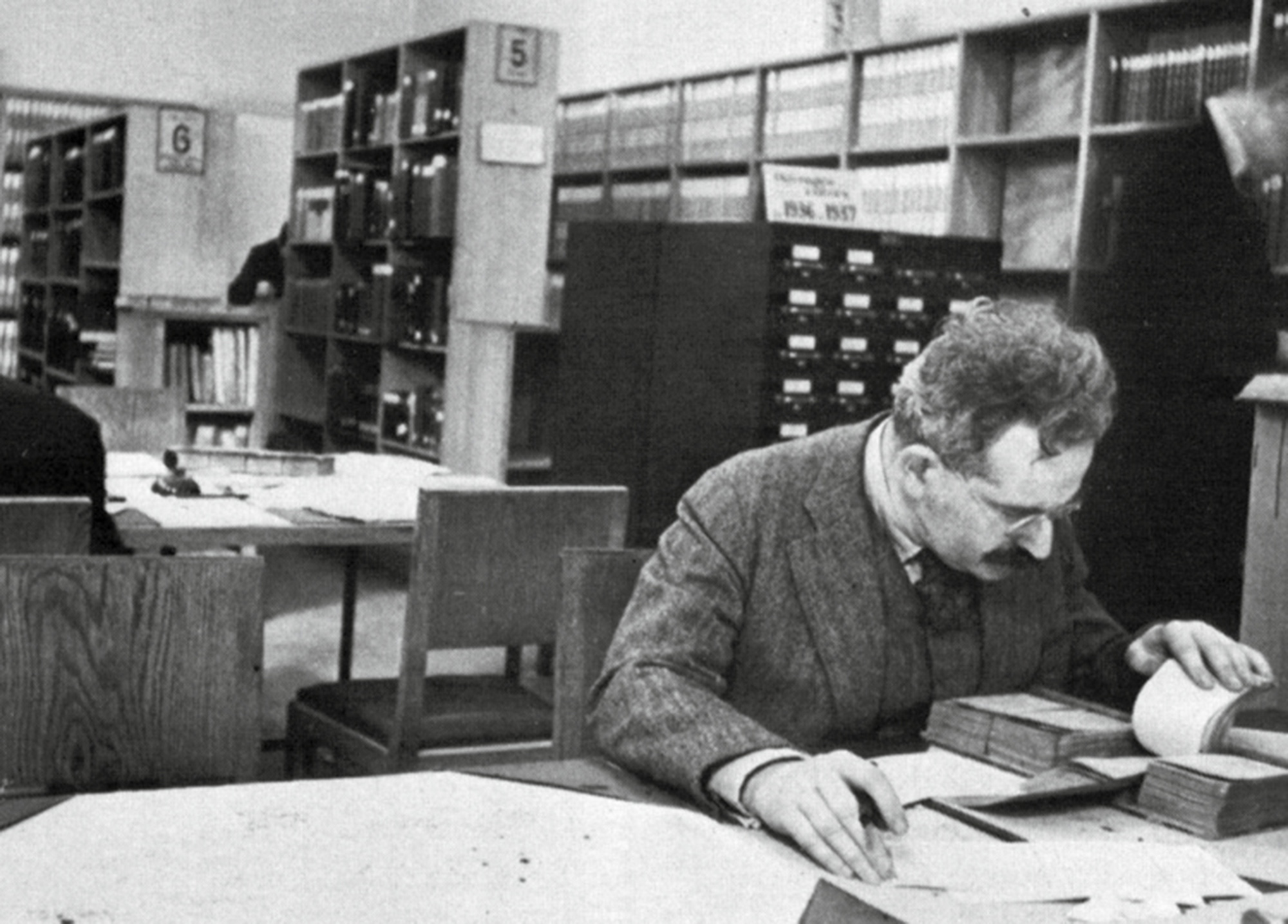
The transition from recording bibliographic data (or excerpts, in the case of the scholar or writer) on slips of paper, which may be recombined in a book as in the case of Gessner, to storing those slips in a special cabinet—this seems crucial in practical terms. But how essential is the physical cabinet to the way the concept of the card index develops?
Your readers might be disappointed, but I have to admit that the cabinet is not so important in this process, at least not at the beginning of the era of excerpting. The software, the set of rules and habits, is much more important than the hardware, than the containers, boxes, cabinets, and cupboards in which the single sheets are deposited. The reason is simple, since the recommendation to store crucial information on slips of paper is only referred to as an intermediate step. Therefore, Gessner and his direct successors always stress that one must fix the newly arranged order by gluing the slips onto large sheets of paper, or better, by copying the new sequence into bound books again. The physical container of the slips becomes more important when the conglomeration of data becomes large enough that the scholar or librarian or whoever is not able to fix or copy it anymore. Then new devices become necessary, and people start being creative. Gottfried Wilhelm Leibniz, one of the last polymaths, acquired a room-filling cupboard that specifically met his needs because he could hook his slips on systematized wooden slats, equipped with nails to fix his paper within different categories and also to remove them again and assign them to another slat. Georg Harsdörffer, a lifetime before Leibniz, had designed a simple box with twenty-four drawers, one for each letter of the alphabet, to put the slips into, but this, again, was only for temporary use. After Leibniz and his slip-cupboard, hardware that aids thinking becomes more frequent, since from time to time the notebooks, excerpts, and other papers are cut, as Gessner recommended in step three and four, into slips. And given the quantity of information—too much now to be copied and fixed into bound books—that had to be stored reliably, wooden cabinets, hybrid books (with, paradoxically, bound loose leafs to be removed), and special scholar devices like the slip-cupboard began to come into wider use. But Leibniz was also a librarian, and in this context, the history of stabilized devices for the slips of paper that met the needs of librarians takes a different route from the scholarly use. The devices are focused on teamwork rather than on individual scholars and their idiosyncrasies; they have to respond to interoperable use rather than being operated by only one person who exclusively knows the keys and rules. And these requirements are reflected in the way the paper piles are stored. In the Royal Library in Vienna, where the first permanent card catalogue is “invented” by neglecting the fifth step of Gessner’s algorithm in 1780, they use boxes that resemble the shape of large bound catalogues, though they only contain loose leafs.
What’s the relationship between library science and bureaucracy at the end of the eighteenth century? It seems there’s a correspondence between the library catalogue and the invention of house numbers in Vienna.
The development of the card catalogue in Vienna in the last period of Maria Theresa’s reign (and in the early years of her son Joseph II’s reign), and the invention of the house number in the same decades, at first sight do not seem to have anything in common—besides the fact that they took place in the same city and under the same conditions of enlightened absolutism. However, if you take a closer look at the ideas and regimes behind that apparent coincidence, the same rules (and rulers) appear to be at work—in both cases, it is the idea of addressability and the need to navigate vast amounts of information. How to single out a specific element within an unstructured crowd? The solution, of course, is to make the crowd addressable, to structure it, which means counting the people or books, registering them, addressing them via their place (house in the street or space on the shelves) and noting that information in catalogues. Both processes deal with a flood of elements: the house numbering is the result of a royal decree to recruit new soldiers; the book numbering is the reaction to a steady stream of books that swamp the royal library due to the breaking up of libraries belonging to Jesuit monasteries, which finally yields the first real library card catalogue. Both processes are initiated and controlled by the same authorities; both can be considered as an administrative answer to the problem of addressability.
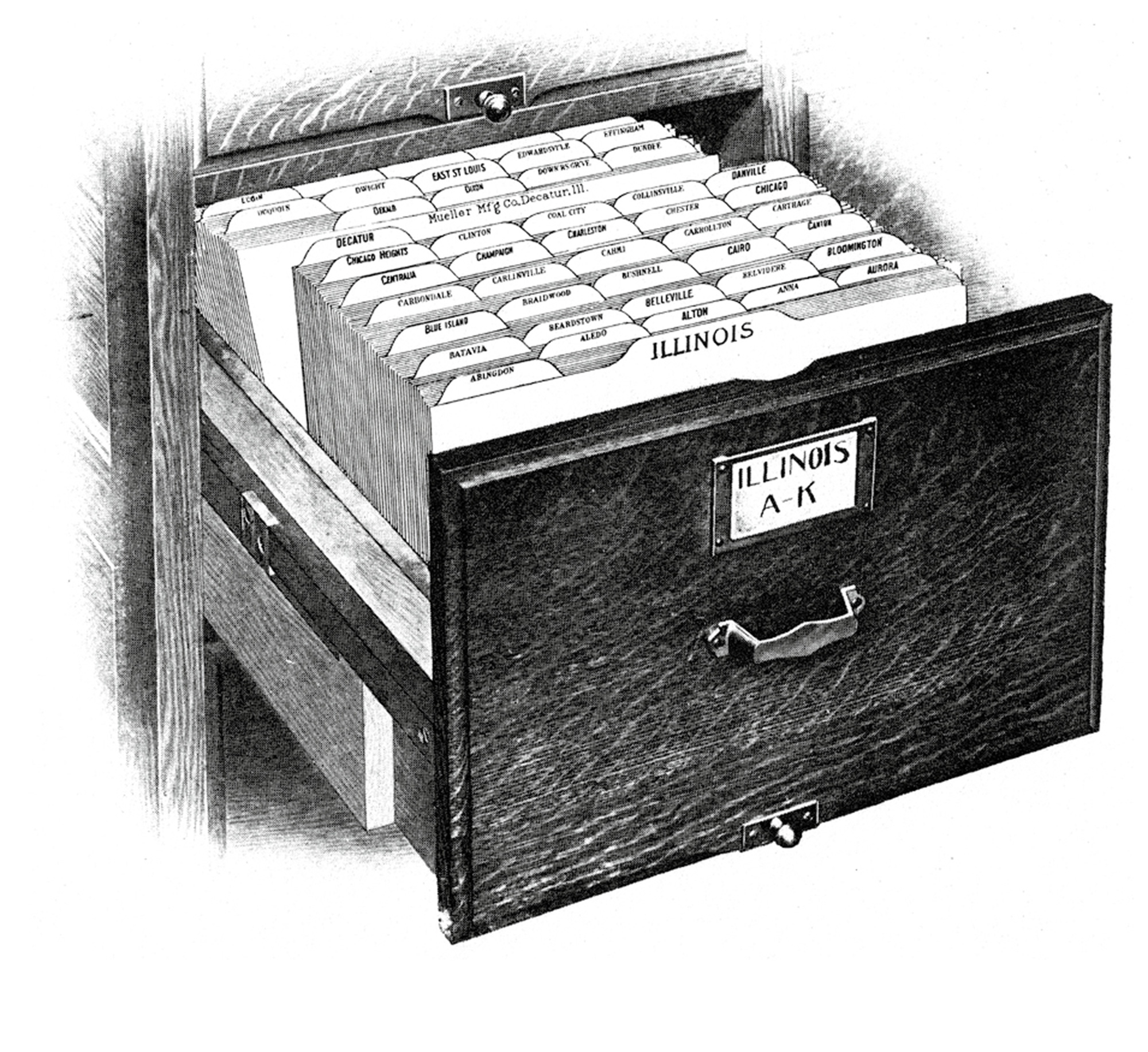
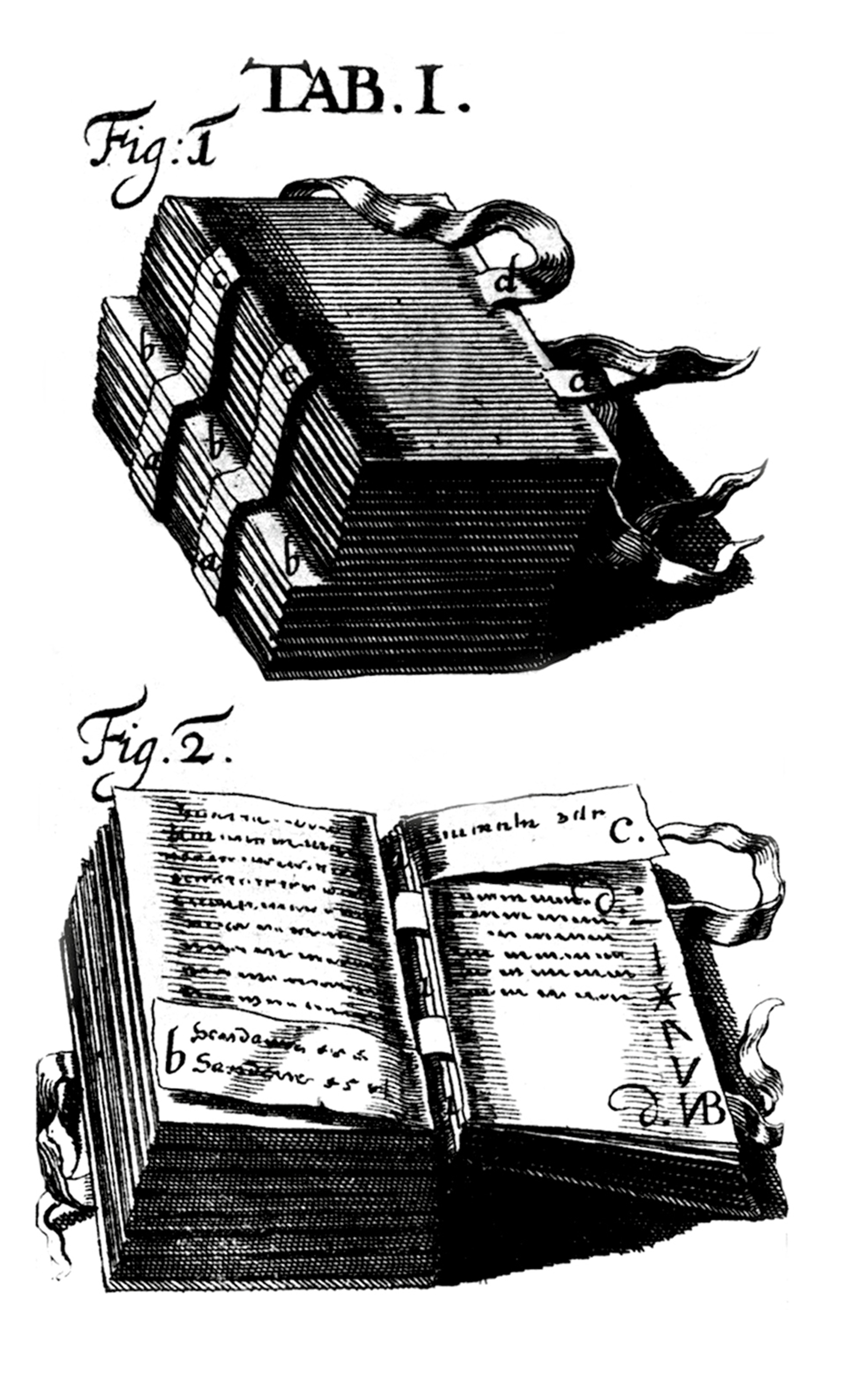
Middle and bottom: Two views of a hybrid card index in book form, from Vincentius Placcius, De Arte Excerpendi: Vom gelahrten Buchhalten (1689).
You write that the card index allows for a new concept of the writer or scholar who recombines excerpts or information stored on index cards, and that this idea is threatened by the rise of the Romantic notion of original genius. But this happens at a time when Romantic writers are using increasingly fragmentary or aphoristic forms (Schlegel, for example.) Is the index card solely a stage or a tool in the production of a larger, synthetic, work—or might it also be a model for new literary forms?
Though Romantic authors often referred to this kind of Genieästhetik (the production mode of a literary genius), I would argue that the notion of a poet being creative all by himself has a slightly longer tradition; Goethe and other pre-Romantics had been influenced by Edward Young’s Conjectures on Original Composition of 1759. The interesting development is that the formerly open technique of working with excerpts and slips of paper to write either fiction or non-fiction is becoming opaque during Goethe’s era.Goethe himself, a learned lawyer, followed a strict system of keeping files in an accurate order, similar to the systematic arrangement of slips in boxes, but he rarely spoke about it because it might chip away at his solid status as an author-genius. Already in Goethe’s lifetime, Romantic authors tried to break with this notion of authoring, and their tendency towards aphoristic, fragmentary short notes can in some cases be understood to be a result of hardware like the card index. And Heinrich Heine goes so far as to deconstruct the image of the genius by ridiculing the general secrecy with which those authors administered their citations and material collections.
Later, however, in the case of modern literature, this method of singling out specific thoughts and insights like unconnected paper slips, becomes a new genre. Think, for example, of Vladimir Nabokov’s Pale Fire, where index cards play a crucial role not only in the narrative but also in the author’s way of designing and writing the novel. (Not to mention his last work, The Original of Laura, the index cards for which were recently published, against the wishes of the late author.) Or Arno Schmidt’s Zettels Traum, which refers to Shakespeare, but has been exclusively drawn from a Zettelkasten or card index.
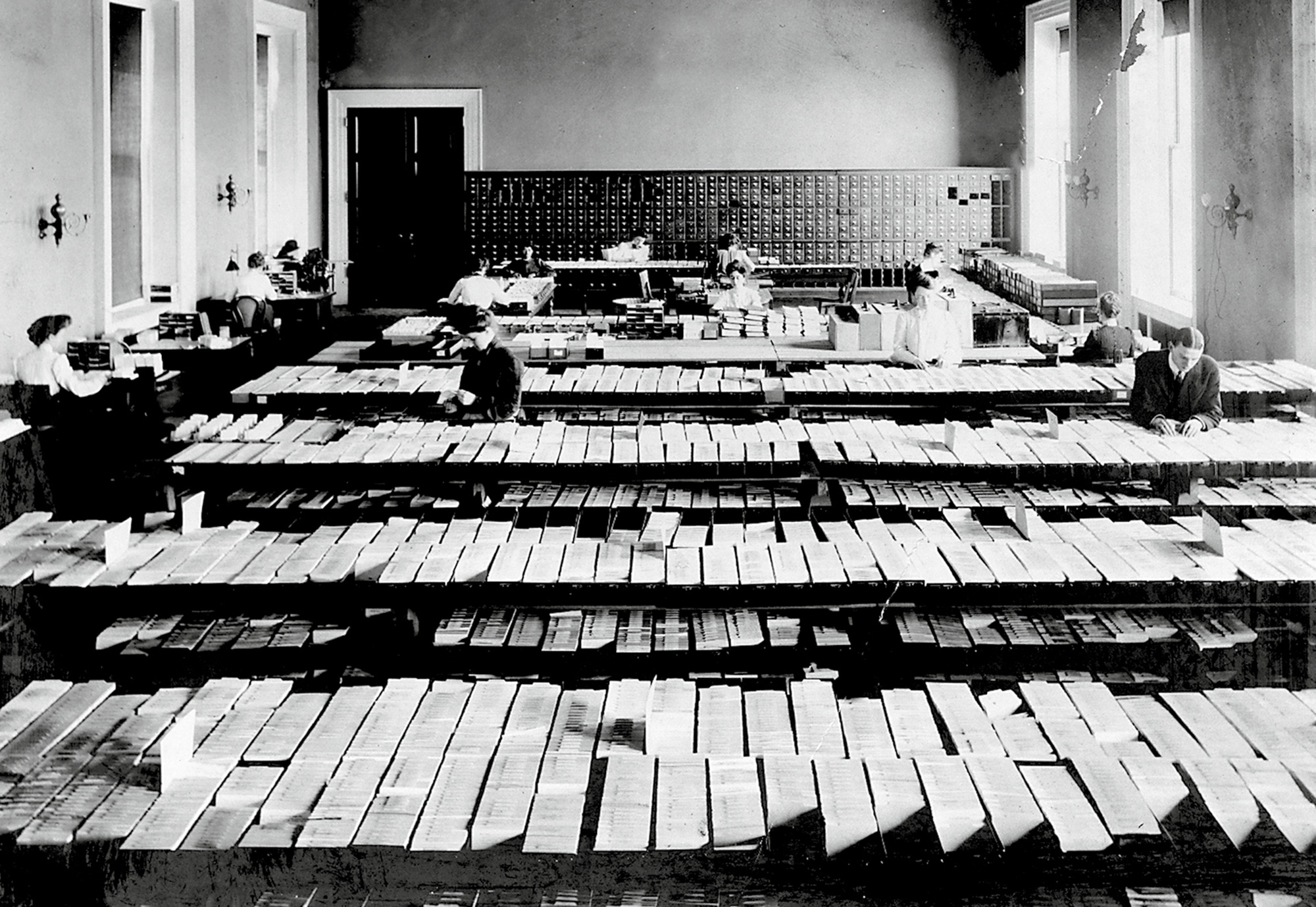
The story of the origins of the card catalogue at Harvard is a fascinating one. Is it true that William Croswell really hits on the card index out of panicked necessity, quite in isolation from previous developments?
As far as I can pursue the brittle traces of this peculiar story of an untrained person who by chance becomes a librarian at Harvard College Library, and by total accident also becomes the inventor, though never acknowledged, of the American card catalogue, William Croswell did not know about any (exclusively European) predecessors of this bibliographical technique. He starts as a teacher of mathematics and dabbles a bit in astronomy before he is hired by Harvard. His qualifications consist merely in being “acquainted with ancient and modern languages,” trained to write a fair hand, and “ready in detecting literal errors.” How could Croswell, then, possibly know about the developments in European libraries? Of course, one might guess that he consulted Gessner’s Bibliotheca Universalis to learn how to prepare bibliographies. However, my investigations showed that Harvard purchased two copies of Gessner’s book much later, in the early twentieth century. Other contemporary news about the European library tradition was also scarce in Cambridge at the time, and I would assume that Croswell adopts the cutting-edge rules of modern librarianship rather unconsciously. He obeys the newly formulated rule laid out by Martin Schrettinger in his 1808 textbook for librarians, without knowing it: not to read or write anything but catalogues. With one small exception: he kept a diary where he meticulously noted what he did, often summed up in one word: “nothing.” So, Croswell refrains from writing this catalogue for about nine years; he prefers to swim in the Charles River, even in winter. In the end, when Harvard president John Kirkland begins to lose patience and forces him to deliver, Croswell quickly cuts old bound catalogues into slips of paper, adds some more titles, and rearranges the whole bunch into the new slip or card catalogue. In doing so, he casually “invents” the American card catalogue, in total ignorance of both librarians’ discourse in general and the earlier developments in Vienna and elsewhere.
Melvil Dewey’s Library Bureau succeeded, after some false starts, in expanding the use of card indexes in business and bureaucratic contexts at the end of the nineteenth century, but many important libraries held out much longer before adopting his system. Were they persuaded eventually from within the world of library science, or did the general spread of such information systems in the late nineteenth and early twentieth centuries also make them more attractive? In other words, did libraries learn from models of “efficiency” in business and industry?
Absolutely. The widespread use of the card index for library purposes is reinforced by the same process of dissemination that the card index as an office technology experiences in the first half of the twentieth century. However, as in many other scenarios when a new technology is gradually adopted, there are the early birds and the reluctant traditionalists, always wrestling about the proper use of the technology. Which is to say, it took a while—it’s better to measure in centuries rather than decades—until librarians trusted loose leafs for storing their information rather than bound catalogue books. As for the commercial realm of business and industry: in Germany, for example, it only took the passage of an 1897 law that allowed bookkeeping on freely floating paper rather than in a solid ledger.
The story of the standardization of the index card’s format and size is also intriguing. Is it possible to say when, if at all, this problem was resolved?
In a way, this problem was solved in pretty much the same way as the standardization of the postcard, which was set to 14 centimeters by 9 centimeters by the World Postal Union in 1878 and revised to 15 centimeters by 10.5 centimeters in 1925. In fact, the standard index card for library use was first set to 12.5 centimeters by 5 centimeters by the American Library Association, but this format was only effective in the US. Another attempt took place in 1908, when the Institut International de Bibliographie in Brussels announced a new global format, 12.5 centimeters by 7 centimeters. The problems here are obvious and manifold: the Institut International de Bibliographie was a private venture, led by the pioneering bibliographer Paul Otlet, and this institution was not acknowledged as the authority in the field—not to speak of its range, which in spite of its name was less than global.
Besides, every standard has its deviationists: for example, the almost globally used DIN A paper size format is (still) combated by the US letter format. And what is more, nobody writes postcards anymore. So the question now is whether the problem of standardization has been solved in the digital realm. As far as I can see, different attempts like the MARC (MAchine-Readable Cataloging) project always produce more subprojects with limited ranges: the original MARC standard was used in the Anglophone sphere, whereas Europe and others pursued a substandard, the UNIMARC, until those efforts were fused in the MARC21 standard of 1999. These more specific standards, however, which deal with bibliometric and library issues, are echoed, in a more general way that exceeds the daily problems of libraries, in the descriptors of the Dublin Core Metadata Element Set. The future will show whether this might be a stable solution, or if this format needs to be modified every ten years.

A recurring motif in your book is the idea of a universal bibliography or “world brain”; one of the most ambitious examples is the Bridge in Germany. Why do you think that effort is failing so spectacularly, given the success of such systems in specific contexts such as libraries, businesses, and state bureaucracy? Is it simply a hubristic ambition, or is it perhaps the case that the “world brain” was already diffusely present in the form of generalized information systems, so it was beside the point to try to organize such a network from one starting point?
During my research on Paper Machines it occurred to me that there are deeper, more hidden driving forces behind that urge to collect every tiny piece of information on index cards, to collect them at one central point and claim to be building nothing less than a “world brain.” If you pursue the background and foundations of that problem of completeness, you encounter ideas about all-encompassing systems or networks already in the second half of the nineteenth century. These notions, however, were developed in a totally different, more technological realm, driven by the global traffic in goods and information and the need to connect as many places as possible. To give a very brief answer: one reason for the spectacular failure of these hubristic projects—besides the conflicting relation between rhizomatical and hierarchical organizational structures—lies in the definition of the projects themselves. The concept is based on an important distinction between the person who conceives the scheme and the staff who are in charge of realizing the idea. It is one thing to build castles in the air, but it is another thing to execute those ideas, and the planners simply did not consider the heavy drudgery implied by collecting all the information in the world. In the case of the Bridge, the result of the “world brain” was nothing more than a complete collection of postcards of the Bavarian town of Ansbach. Often, ambitious projects end up in a situation that Hegel called bad infinity.
Markus Krajewski is associate professor of the media history of science at Bauhaus University, Weimar. He is author of several books, including As For the Rest: World Projects and Notions of Globality around 1900, forthcoming in 2013 from the University of Minnesota Press. His current research projects include the media and cultural history of servants; the epistemology of the peripheral; and the history of exactitude in scholarly and scientific contexts. He is also developer and maintainer of the bibliography software Synapsen, a hypertextual card index, available for download at verzetteln.de/synapsen.
Brian Dillon is UK editor of Cabinet and tutor in the Critical Writing in Art and Design program at the Royal College of Art, London. His books include I Am Sitting in a Room (Cabinet, 2011), Sanctuary (Sternberg Press, 2011) and The Hypochondriacs (Farrar, Straus & Giroux, 2010). His writing has appeared in the Guardian, frieze, the London Review of Books, and Artforum. His Attention! Essays 2003–2013 will be published by Sternberg Press in spring 2013. He lives in Canterbury.